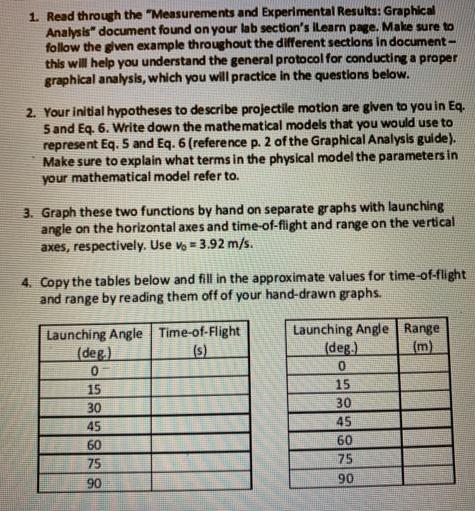Answered step by step
Verified Expert Solution
Question
1 Approved Answer
1. Read through the Measurements and Experimental Resuts: Graphical Analysis document found on your lab section's ILearn page. Make sure to follow the given


1. Read through the "Measurements and Experimental Resuts: Graphical Analysis" document found on your lab section's ILearn page. Make sure to follow the given example throughout the different sections in document- this will help you understand the general protocol for conducting a proper graphical analysis, which you will practice in the questions below. 2. Your initial hypotheses to describe projectile motion are given to you in Eq. 5 and Eg. 6. Write down the mathematical models that you would use to represent Eq. 5 and Eq. 6 (reference p. 2 of the Graphical Analysis gulde). Make sure to explain what terms in the physical model the parameters in your mathematical model refer to. 3. Graph these two functions by hand on separate graphs with launching angle on the horizontal axes and time-of-flight and range on the vertical axes, respectively. Use vo = 3.92 m/s. 4. Copy the tables below and fill in the approximate values for time-of-flight and range by reading them off of your hand-drawn graphs. Launching Angle | Time-of-Flight (deg.) Launching Angle Range (deg.) (s) (m) 15 15 30 30 45 45 60 60 75 75 90 90 Projectile Motion Introduction For a projectile launched with an initial speed, Vo, and angle, 6, above horizontal, the x-and y-components of the initial velocity are: Vox = vo cose (Eq. 1) Voy = vo sin e (Eq. 2) Due to the constant downward acceleration of gravity, g, the kinematic equations of motion are: Range =x - xo = Voxt (Eq. 3) y- Yo = Voyt --gt (Eq. 4) where xo is the starting horizontal position, yo is the starting height, x is the final horizontal position, y is the final height, and t is the total time of flight. If we take the assumption that the final y-position is equal to the initial y-position v = yd, then we can rearrange these equations to solve for time-of-flight and range in terms of the projectile's initial velocity and launching angle: sin (Eq. 5) Ran ge = x- x = -sin 8 cos 0 = sin 20 (Eq. 6) %3D Experimental Apparatus: Landing Pad Timer Platform Photogate Tngger
Step by Step Solution
★★★★★
3.52 Rating (159 Votes )
There are 3 Steps involved in it
Step: 1
tota So Vo is intal volouly w th proje tble has heen angle o thrown raki...
Get Instant Access to Expert-Tailored Solutions
See step-by-step solutions with expert insights and AI powered tools for academic success
Step: 2

Step: 3

Ace Your Homework with AI
Get the answers you need in no time with our AI-driven, step-by-step assistance
Get Started


